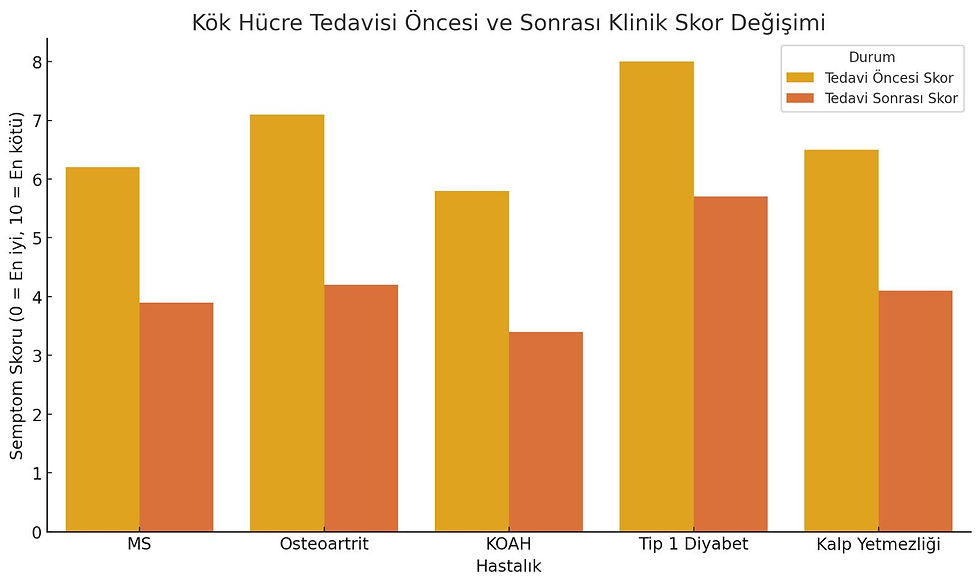

Stem Cell
Stem cells are specialized cells that form the fundamental building blocks of the human body. Thanks to their ability to self-renew and transform into different cell types, they play a critical role in repairing damaged tissues and organs. Because of their immense regenerative capacity, stem cells have become a promising medical option for treating various diseases.
Stem cells are specialized cells that form the fundamental building blocks of the human body. Thanks to their ability to self-renew and transform into different cell types, stem cells can replace missing or damaged cells in the relevant tissue or organ when needed. They can be effectively used in the repair of tissue damage caused by injury, disease, or other causes. The ability of these cells to support the body's healing process by performing tissue-specific functions has led to revolutionary advances in many fields of medicine and plays a critical role in the repair of damaged tissues and organs. Because of their immense regenerative capacity, stem cells have become a promising option for treating various diseases in medical treatments.

Stem Cell Types
Hematopoietic Stem Cells
Hematopoietic stem cells are abundant in bone marrow and cord blood, the body's blood-producing centers. These cells play a critical role in the production of blood components, including red blood cells, white blood cells, and platelets. The term "hematopoietic" literally means "blood-forming." They are widely used in the treatment of leukemia and other blood disorders.
Mesenchymal Stem Cells (MSCs)
Mesenchymal stem cells are the primary cells of connective tissue and can be obtained from cord tissue. They have the ability to differentiate into various cell types, including fat, bone, cartilage, muscle, tendon, and ligament. Mesenchymal stem cells are used in a wide range of treatments, from spinal disorders to orthopedic conditions.
Stem Cell Prices
Stem cell treatment prices can vary depending on the type of disease being treated, the type of stem cell used, and the application method. For mesenchymal stem cell treatments in particular, the expertise of the clinic where the treatment is performed and the technical equipment used can contribute to price differences. It's important to obtain a detailed expert opinion before developing a treatment plan.
Stem Cell Therapy: Scientific Developments and Application Areas
Stem cell therapy is a promising support method for many diseases today.
Cellular therapies, especially tissue repair and immunity
offers innovative solutions in situations where the system needs to be adjusted.
Stem cell centers in Istanbul provide world-class service to both local and international
and delivers this innovation to foreign patients.
What is a Stem Cell?
Stem cells have the ability to transform into different cell types in the body and renew themselves.
are special cells with the capacity to repair damaged tissues. Thanks to these cells,
The progression of some chronic diseases can be slowed down.
Stem cells are examined in two main groups:
Embryonic stem cells can develop into all types of cells.
- Adult stem cells (e.g. MSC - mesenchymal stem cell): Tissue repair and immunity
used for editing purposes.
In Which Diseases Are Stem Cells Used?
According to clinical research, stem cell therapy has a supportive role in the following diseases:
It has been reported that he can play:
- Multiple Sclerosis (MS)
- Parkinson's Disease
- Osteoarthritis (Knee, Hip calcification)
- COPD (Chronic Obstructive Pulmonary Disease)
- Type 1 and Type 2 Diabetes
- Heart failure
- Liver and kidney failure
- Rheumatoid Arthritis, Lupus
- Eye diseases such as Retinitis Pigmentosa, Stargardt
- Post-stroke rehabilitation

Reliability and Certification
Kök hücre tedavileri Sağlık Bakanlığı onaylı merkezlerde, GMP (Good Manufacturing
Practice) standartlarında ve gerekli etik kurallar çerçevesinde uygulanmaktadır. ABD’de
FDA ve Avrupa’da EMA gibi kuruluşlar da bazı hücre tedavilerini klinik araştırmalar
kapsamında desteklemektedir.
Treatment Process
1. Patient evaluation and preliminary interview
2. Laboratory tests and conformity control
3. Stem cell supply (bone marrow, fat tissue, cord blood, etc.)
4. Administration (intravenous, intra-articular, spinal, etc.)
5. Post-treatment follow-up

Stem Cell Therapies and Application Areas
In recent years, stem cell therapies have gained importance, particularly in the treatment of degenerative diseases. Their goal is to repair damaged or dysfunctional tissues and organs with a sufficient number of high-quality stem cells, restoring their former function. Stem cell therapies are used in a wide range of conditions, including cancer, heart disease, diabetes, and nervous system disorders.
